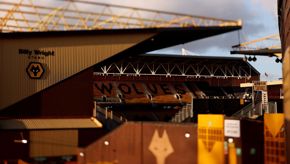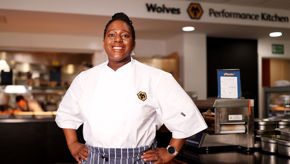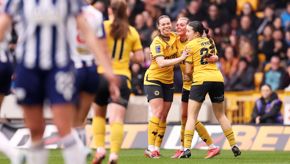There is not many other people who fit that description than Don Gardner - the first black player to put on a gold and black shirt for Wolves in a competitive fixture.
Yesterday, wolves.co.uk provided a brief history of Gardner's short-lived Wolves career, but with Black History Month set to come to a close today, we go into more depth, hearing from the man himself.
Four years ago, journalist, author and former Wolves reporter for the Express & Star, David Instone, started a hunt to find Gardner and discover what he has been up to since he left the club back in 1975.
Having finally tracked down the attacking midfielder for his website, Wolves Heroes, Instone, author of the recently-published 'Wolves 1970s Scrapbook' (produced by Thomas Publications and priced at £16.99, with profits going largely to charity), has shared his conversation with wolves.co.uk, as we celebrate a man who set a legacy for all the black players who have represented the old gold since to follow.
***
For years, we despaired of ever catching up with him, resigned as we were to the fact he had not stayed in touch with any team-mates and had left town long ago.
There was little or no trace but the internet is a wonderful tool and brought one of his friends to our aid earlier this summer as he offered himself as a go-between in the connection process.
And so, across several phone conversations, we have learned something about the utility man Bill McGarry blooded in the spring of 1975 but who disappeared from public view in these parts almost as soon as he was welcomed to the big stage.
He lives in Birmingham, he flourished in business after also playing in America and the cheerful personality he has been blessed with is now coming in useful as he recovers from illness and surgery. He laughs easily and often. So now, at last, we are delighted to share some of his story….
Gardner’s parents were part of the Windrush generation and gave him an unusual start in life. Although resident in Edgbaston, they decided it was too cold here for a child to spend their early months, so he was taken back to Jamaica in the womb and his initial sight of the outside world came in Falmouth on the island’s north coast.
The young Donald spent his first year and a half in the Caribbean and, back in the West Midlands, played football from a young age, although we will return briefly later to the West Indian national sport of cricket.
“I didn’t really support any one of the local clubs….I sort of liked them all,” he said. “As time went on, I represented Birmingham Boys and played for them at St Andrew’s.
“The PE teacher at Portland Road Secondary School in Edgbaston was a Mr Mellor, who was very good to me, taking me to trials as well as encouraging me.
“I attracted plenty of scouts….including from Everton, Blues, Villa, Coventry and Manchester United, but didn’t think that much of it. The better players at that level all had people watching them.
“Coventry were doing well at the time, so I had trials there and also went for training with England Boys at Manchester United. I remember being in this facility that had an indoor pitch and seeing Bobby Charlton and George Best among the United first-team players having a session nearby. It wasn’t unusual for a ball to be kicked over towards them, so we could wander over and say: ‘Mr Best, can we have our ball back, please?'” Cue more laughter.
“I spoke to him once or twice – he was still playing then – and was also noticed by Wolves. I can’t remember who spotted me from there but I know Coventry weren’t too pleased when I said I preferred to go elsewhere. Although I had signed schoolboy forms, it was hard for a club to keep you at the age of 15.”
We must bear in mind that it’s more than 45 years since Gardner was seeking a way into First Division football. Unlike many of his contemporaries, he hasn’t had the benefit of dinners and other reunions to refresh – and even embellish – the memories.
He has been off the radar and out of the loop but the day he made his first-team debut, in a 5-2 home victory over Luton, remains a highlight.
“I could play on the wing, inside or off the front man and was seen as an impact player as I had speed. I loved playing with Peter Withe because I could get on the end of his flicks and be in the area with one or two touches.
“I was a good get-out ball because the other lads knew they could knock it long and there was a chance I might get on the end of it and win us a throw-in or something.
“I nearly scored after going on for Steve Kindon against Luton. I think it was a header at the near post which the keeper just got to on the line. That would have been a big moment for me.”
His stock was high enough to be picked up to play that summer for Portland Timbers. A West Midlands migration also took four of his Molineux colleagues, Withe, Barry Powell, Jimmy Kelly and Chris Dangerfield, to America’s west coast, where Tipton-born former Villa youngster Mick Hoban was another linking up under the leadership of Vic Crowe.
Did it prove to be the dream move? “No. In America, most of the pitches were Astroturf and that didn’t suit my game,” Gardner said. “I was all about speed and sharp turns and the surfaces were unforgiving, so I got a lot of strains and other problems with my ankles and knees.
“I am sure they are a lot better now but I remember thinking it was like playing on concrete with a few inches of softer material at the top.”
As the Molineux door started to close in the spring of 1975, it would have been good to report that the adopted Brummie found fulfilment faraway. Alas, it didn’t work out that way.
“I had a spell with Connecticut Bicentennials after Portland but I heard while I was over there that both of my parents were unwell, so I came home to help look after them. They picked up thankfully, although they have both passed away now.
“I played pretty well when I was fit but missed too many games with strains and I became a bit disillusioned with it there and after I returned. I had a short spell with Port Vale that didn’t come to anything and there was some talk of me going to Crewe or to Hong Kong or Australia.
“But I had no interest in travelling all that way and didn’t do anything more than play a bit of local football after that. I had played since I was eight and, with my fitness problems, had lost some of my enthusiasm for the game.
“Being the first black player to represent Wolves really didn’t mean much. Yes, there was some abuse and we were made aware that we were viewed very differently. I became friendly with Laurie Cunningham even before he joined Albion and later got to know Cyrille Regis and we were used to bananas being thrown on the pitch.
“But I just saw myself as another footballer who was trying to get into the first team and stay there. That was enough of a challenge and the other things didn’t affect me.
“I was so determined to progress. Besides, the way to beat any resistance that there was because of my colour was just to play better.”
***


